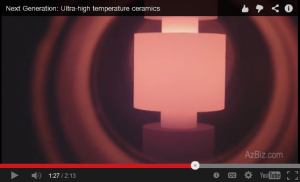GT is likely showcasing it’s Spark Plasma Sintering (SPS) technology in Orlando based on the “#sintering” in the company’s tweet. Here is some information on GT’s SPS technology that was acquired through GT’s acquisition of Thermal Technologies as well as the targeted industries this technology can impact.
Thermal Technology Acquisition
GT made it clear almost two years ago that they were interested in getting into thermo electric converters for hybrid electric vehicles. This interest was highlighted the press release when GT acquired Thermal Technology.
The company has also acquired Spark Plasma Sintering (SPS) technology, which allows dense ceramics to be obtained under uniform heating at relatively low temperatures and in short processing times. The SPS technology is expected to have a wide range of applications including with medical applications, sputtering targets, space applications and thermoelectric converters for hybrid electric cars.
One important item to highlight is Spark Plasma Sintering (SPS) technology, this wild machine turns ceramic powder into a dense crystalline material in less than 5 minutes versus other machines that take hours. GT envisions using this technology to and their ceramic patent (acquired through GT’s purchase of Twin Creek’s Technology) to create a thin semiconductor lamina adhered to a ceramic body. The ceramic bodies would be formed using GT’s SPS technology. The patent states that devices can be formed in the lamina, including photovoltaic devices. The ceramic body and lamina can withstand high processing temperatures. In some embodiments, the ceramic body may be conductive. This ceramic patent also involves Hyperion to produce thin semiconductor lamina.
THE SPS PROCESS
Unique to SPS is the DC current generating heat internally, as opposed to conventional methods of materials densification such as hot pressing, wherein the heat is external to the sample. While other traditional methods of materials processing require hours to reach peak temperature, Thermal Technology’s SPS takes only minutes. The clear benefits of SPS are the significant savings of time and energy and the ability to retain nano-structures.
Full Disclosure I am long GTAT and I have joined PTT Research. My premium Forensics Newsletter is scheduled to launch on June 2nd. The premium paid service option will grant my paid subscribers exclusive content weeks before my analysis is published on Seeking Alpha, the Obscure Analyst blog or any other website. Another advantage of PTT is the subscriber Forum that allows sharing of ideas and analyst Q&A.


I hope they say something to get this stock up again. I am underwater at the moment but am holding on. Seems like there is good support at $14 but look out below if Apple doesn’t support it with good news. What do you think that Apple might say at the conference on June 2nd? Thanks
LikeLike
I don’t think they mention the iPhone 6. I would be very very surprised.
LikeLike
I read somewhere that SPS can be used to make sintered sapphire approach transparency from opaque. …..at cell phone thicknesses is that transparent enough??? Could be big cost savings.
Also Gorilla glass is amorphous, I believe, and sapphire is single crystal. Is there any reason that sapphire has to be single crystal or is that where the strength comes from.
LikeLike
Sapphire is, by definition, crystalline. Glass is, by definition, amorphous. They’re inherent material characteristics.
LikeLike